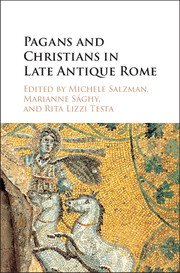 Pagans and Christians in Late Antique Rome
Pagans and Christians in Late Antique Rome Book contents
- Frontmatter
- Contents
- List of Illustrations
- Biographies of Authors
- Acknowledgments
- Introduction
- Part I SENATORIAL POLITICS AND RELIGIOUS CONFLICT
- 1 Constantine and the Roman Senate: Conflict, Cooperation, and Concealed Resistance
- 2 Beyond Pagans and Christians: Politics and Intra-Christian Conflict in the Controversy over the altar of Victory
- 3 Were Pagans Afraid to Speak Their Minds in a Christian World? The Correspondence of Symmachus
- Part II The Construction of New Religious Identities
- Part III Pagans and Christians: Coexistence and Competition
- Section A Pagans and Religious Practices in Christian Rome
- Section B Death and the Afterlife
- Section C Reading Religious Iconography as Evidence for Pagan–Christian Relations
- Concluding Remarks: Vrbs Roma between Pagans and Christians
- Index
- References
1 - Constantine and the Roman Senate: Conflict, Cooperation, and Concealed Resistance
from Part I - SENATORIAL POLITICS AND RELIGIOUS CONFLICT
Published online by Cambridge University Press: 05 November 2015
- Frontmatter
- Contents
- List of Illustrations
- Biographies of Authors
- Acknowledgments
- Introduction
- Part I SENATORIAL POLITICS AND RELIGIOUS CONFLICT
- 1 Constantine and the Roman Senate: Conflict, Cooperation, and Concealed Resistance
- 2 Beyond Pagans and Christians: Politics and Intra-Christian Conflict in the Controversy over the altar of Victory
- 3 Were Pagans Afraid to Speak Their Minds in a Christian World? The Correspondence of Symmachus
- Part II The Construction of New Religious Identities
- Part III Pagans and Christians: Coexistence and Competition
- Section A Pagans and Religious Practices in Christian Rome
- Section B Death and the Afterlife
- Section C Reading Religious Iconography as Evidence for Pagan–Christian Relations
- Concluding Remarks: Vrbs Roma between Pagans and Christians
- Index
- References
Summary
Constantine's relations to the senate and to Rome's resident senatorial aristocracy have attracted a good deal of scholarly attention, but not consensus. In the aftermath of World War II a number of scholars followed a view developed by Hungarian scholar András Alföldi, who characterized that relationship as conflict-ridden and filled with friction between an aggressively Christianizing emperor and a staunchly pagan senatorial aristocracy, the only pagan group capable of resisting. In Alföldi's view, imperial laws advanced Christianity and any policies that favored senators or paganism were grudging concessions to a strong, overtly hostile pagan political party. Alföldi's model has been called into question. Since the 1980s, some scholars have argued that there was no religious or political conflict and no resistance on the part of Rome's once pagan senatorial aristocracy who, increasingly Christian themselves, simply acquiesced to a newly Christianized empire. Other scholars have argued that because Constantine was either tolerant of pagans, or was not a “really” committed Christian, there was no religious or political conflict with Rome's pagan senate and senatorial aristocracy. And others have argued that religion was not relevant to this relationship; as Van Dam sees it, appeals to religion were part of the language of power, not a source of conflict in and of themselves.
In my view, the differing opinions in the abundant literature on Constantine's relations to Rome's senate and resident senatorial aristocracy conflate three distinct issues – the nature of the conflict, imperial interest in Christianization, and the power of the senate and senators to speak openly. Consequently, some scholars assume a strong, pagan senate confronting an aggressively Christianizing ruler led to overt political and religious conflict. Other scholars assume an acquiescent pagan senate responding to a more or less tolerant Christian emperor resulted in the lack of political or religious conflict. But each element in this narrative requires independent consideration because their conjunction has been based on a number of false assumptions. In particular, the senate, as an institution, is in need of reconsideration for it was limited, politically, in facing an emperor in the early fourth century. Consequently, this chapter aims to disentangle the evidence and reconsider relations between Constantine and Rome's senate and resident senatorial aristocracy.
- Type
- Chapter
- Information
- Pagans and Christians in Late Antique RomeConflict, Competition, and Coexistence in the Fourth Century, pp. 11 - 45Publisher: Cambridge University PressPrint publication year: 2015
References
- 2
- Cited by


